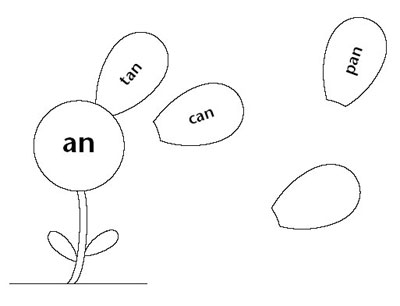Materials
Large chart paper (at least 2’ x 3’)
Markers
Key Skill
Phonics
Activities
- Begin with a key word. In this case we’ve used the word can.
- Help children think of words that rhyme. They can raise their hands to take turns or just call out their ideas if the group is small and quiet enough.
- It’s okay to give clues to help students begin or to keep them going. Try a guessing game: “I’m thinking of a word that starts with ffffff and ends with -an.” Or “I’m thinking of something that starts with /p/ and you use it when you cook bacon and eggs.”
- Ask children to think of words that end in -an (pan, fan, ran, man, tan, van, plan, scan, bran, began). Check to be sure they understand word meanings. For example, ask, “What does van mean?” You can also ask volunteers to use the word in a sentence.
- It helps to say the sounds (not the letter names) clearly as you write each word, one under another. See if children can tell you which letters make some of the sounds you are recording.
- If children are engaged and excited, continue by adding words in the “extended word family”: words that contain -an + t or -an + d. If you do this, be sure to pronounce the last sound clearly, as it may be difficult for students to hear. Some good words to add (in columns) are: and, band, hand, land, sand, stand, ant, can’t, pant, plant, rant, grant, slant, chant, ranch, branch, dance, chance.
- You can expand the list to include two- and three-syllable words (planet, candy, dandy, panda, bandit, banjo, fancy, chance, piano, enchanted) and compound words (landscape, sandpaper, handcuff, cranberry, landlord, handwriting).
- If children suggest a word that isn’t part of the word family, keep a separate list handy labeled “Other Good Words” and write them there.
- Once you’ve created your Word Family Chart, try these extensions:
- Play a phonemic awareness game:
- Say handbag and ask children to repeat it without the hand.
- Say candy and ask children to repeat it without the /dee/.
- Say plant and have children repeat it without the /l/.
- Have children write (or dictate) a sentence or a story with some of the -an words and then illustrate it.
- Ask students to pick two to four words from the list, copy them on paper, and then draw pictures to illustrate them.
- Sing a variation of the BETWEEN THE LIONS song “If You Can Read at” . Begin with “If You Can Read a-n, an, then you can read _____,” and decide which words from your list to include. Make the song into a big book illustrated by the students.
- Make a Word Family Flower:
- Make a flower stem with a round shape on top and print -an inside the circle
- Cut out petal shapes to be added to the flower. Students take a blank “petal,” write an -an word, and, if possible, illustrate it. Each -an word gets added around the center to make a Word Family Flower.
- Play a phonemic awareness game:

Citation
Used with permission of Between the Lions (R).(c) 2007 WGBH/Sirius Thinking. Between the Lions and related marks are trademarks of WGBH.
Reprints
For any reprint requests, please contact the author or publisher listed.
